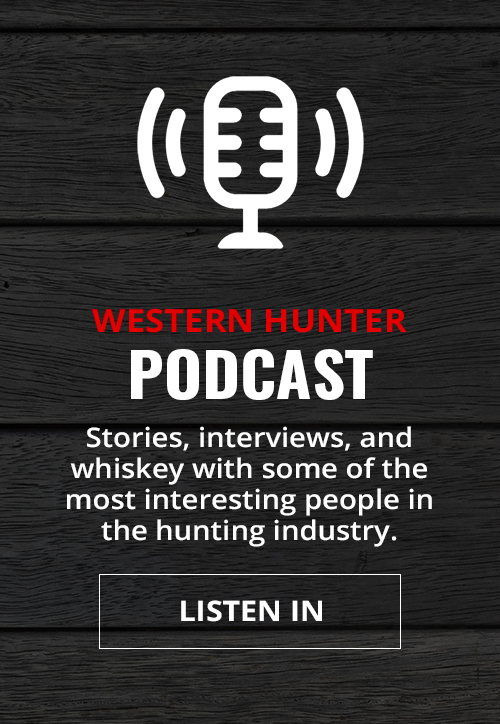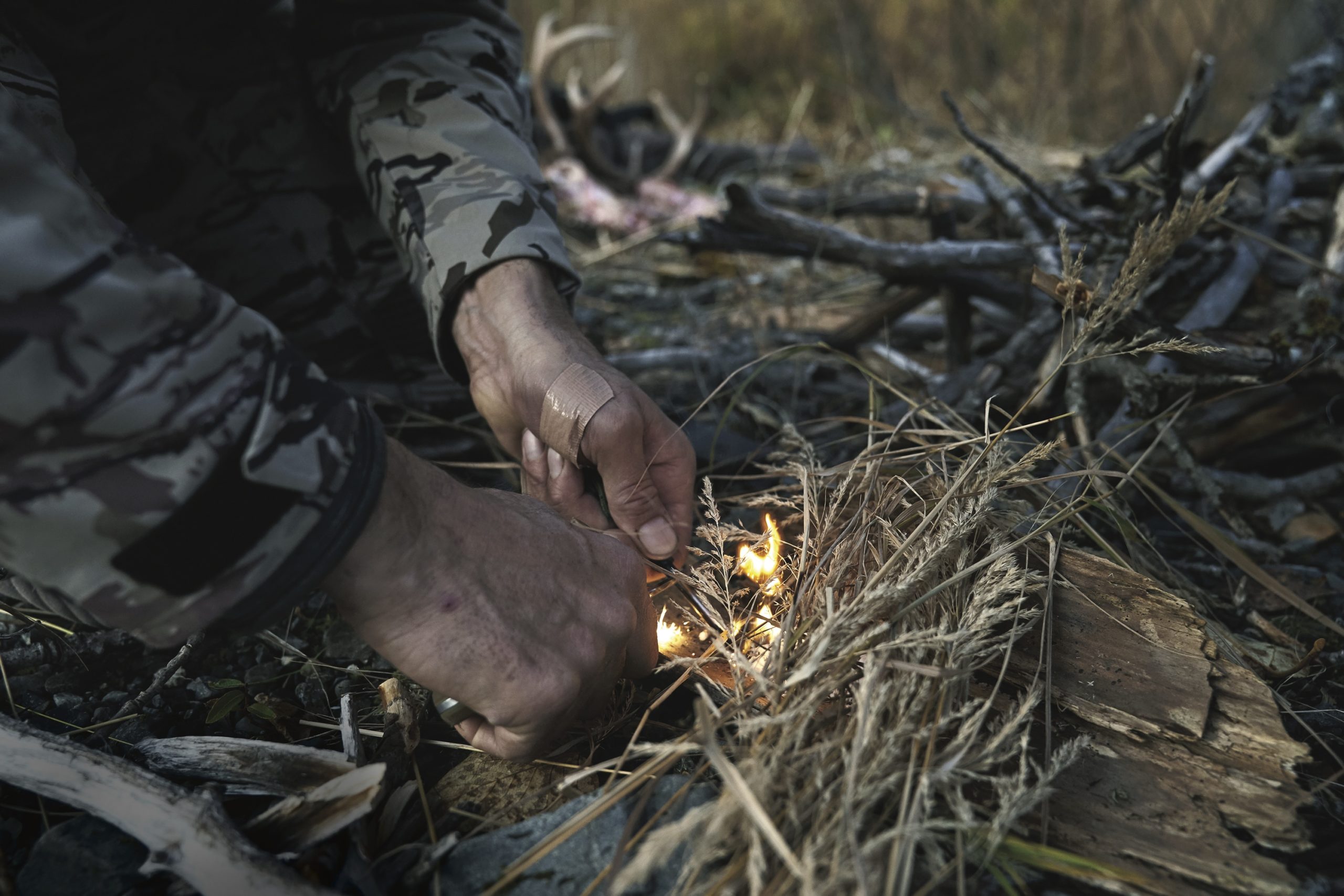
NOTICE: Certain links on this post may earn a commission for Western Hunter Magazine from Amazon or our other affiliate partners when you make a purchase. Thank you for your support.
To Build A Fire
If you are unfamiliar with the classic Jack London short story To Build a Fire, it is a tale of a Yukon miner who makes a mistake, gets wet, then builds his survival fire under a tree full of snow. The snow extinguishes the fire and the man dies of hypothermia. I actually think of this short story a lot when I am out hunting – mostly because I know the importance of being able to build a good fire on the first try. I have on a few occasions found myself in need of a fire and have over the years honed that skill so when I need one the most, I can make it happen.
There is no more important skill than building a fire. It should be something every hunter learns, practices, and is competent in. Fire starting is not always easy and the times you truly need it are the times you can’t mess up. Basic outdoor skills are the ones most often taken for granted. Through guiding and many outdoor interactions, I am always amazed at how few people can quickly and efficiently build fires. Add wet conditions and the difficulty is multiplied. The reason I believe that so many have trouble is an overestimation of ability combined with a lack of practice.
A few years back, I was on a late season backcountry elk hunt. The conditions were cold, frozen, wet, and windy. The jet boils were too cold to work and the only way to get water and warm up was to start a fire. I looked around, gathered my fuel, taking note of the right type of sticks and trees that would aid in building a fire in these conditions. I laid sticks out, prepped it, and in a matter of minutes had a raging fire. The people with me were actually amazed, but for me it was just a simple task done right. I knew what materials to look for. I kept an eye out for what I like to call “super fuels” - stuff that burns hot and fast - like dry pine needles. I gathered the right stuff and built a fire. Now I have built thousands of fires in many different environments so I knew what to look for, but that knowledge only came through practice. I take pride in my fire building ability. In this article I am going to share a few tricks to help you quickly and efficiently master the flame.
Building a Fire
You build a fire much like you build anything. Start small, follow a plan, and have the right materials. You don’t just throw a house up. There are steps you take and things you need. It’s the same with baking. You can't just skip to pulling a cookie out of the oven, yet on that same logic I constantly see people try to start a fire with a large pile of wood; skipping immediately to the end part where they want the fire to be. Building a fire in extreme conditions is all about the right materials, and the right building process to get it right the first time, every time.
The Anatomy of a Fire
Fire needs three things to exist: heat, fuel, and oxygen. Without those, it goes out or never starts. In order to build and maintain a fire, you need something to start the fire with - a catalyst like a match, lighter, striker, etc - something that creates the heat. From there, you will need tinder, kindling, and firewood. Tinder is what will burn and ignite easily. It will hold a flame and be used to light the kindling. Kindling is small sticks that are easily ignited but harder to light than tinder. Kindling in the base of the fire that will be used to ignite the harder-to-light firewood.
Tinder
Tinder can be as simple as a cluster of dry grass or leaves and as advanced as a waterproof/ windproof fire cube that can be purchased at a local sporting goods store. While store bought fire starters are always handy and aid in starting fires, understanding what burns well, burns long, and is easy to ignite is extremely valuable. This comes from understanding a few basics as well as just messing around with different materials in the area you are in by lighting a bunch of random stuff on fire… safely of course.
The key to good tinder is the material being dry and loose or allowing airflow around it. I also like to look for mixing materials that ignite easily with things that burn a long time. Tree sap and pitch is great for long-burning natural fire starter. If in pine country, look for good pieces of dried pitch or pitch on bark. Quick burning tinder includes many mosses like old man's beard or other tree moss. Dry grass can ignite quickly but burn out fast. Also, the inner bark of dead (not rotten) trees is a great option. Shavings from dead branches whittled with your knife can be great tinder especially in wet areas. Much of the best tinder when it is wet out is found using a knife and cutting, scraping and breaking dead materials to get past the wet parts.
One of my favorite ways to start a fire is to mix quick-lighting and long-burning mediums. I will build a small sort of bird nest with grass, moss and small sticks and use that to ignite the longer-burning tree pitch, inner bark, or dry shavings. When I am hunting, I take note of available fire starters and where they are. I keep a small baggy in my pocket to gather pitch and other stuff as I walk around. I especially take note of any dead pine, fir, cedar etc. with dry, brown, dead needles (some of the best fire starter for a quick hot flame).
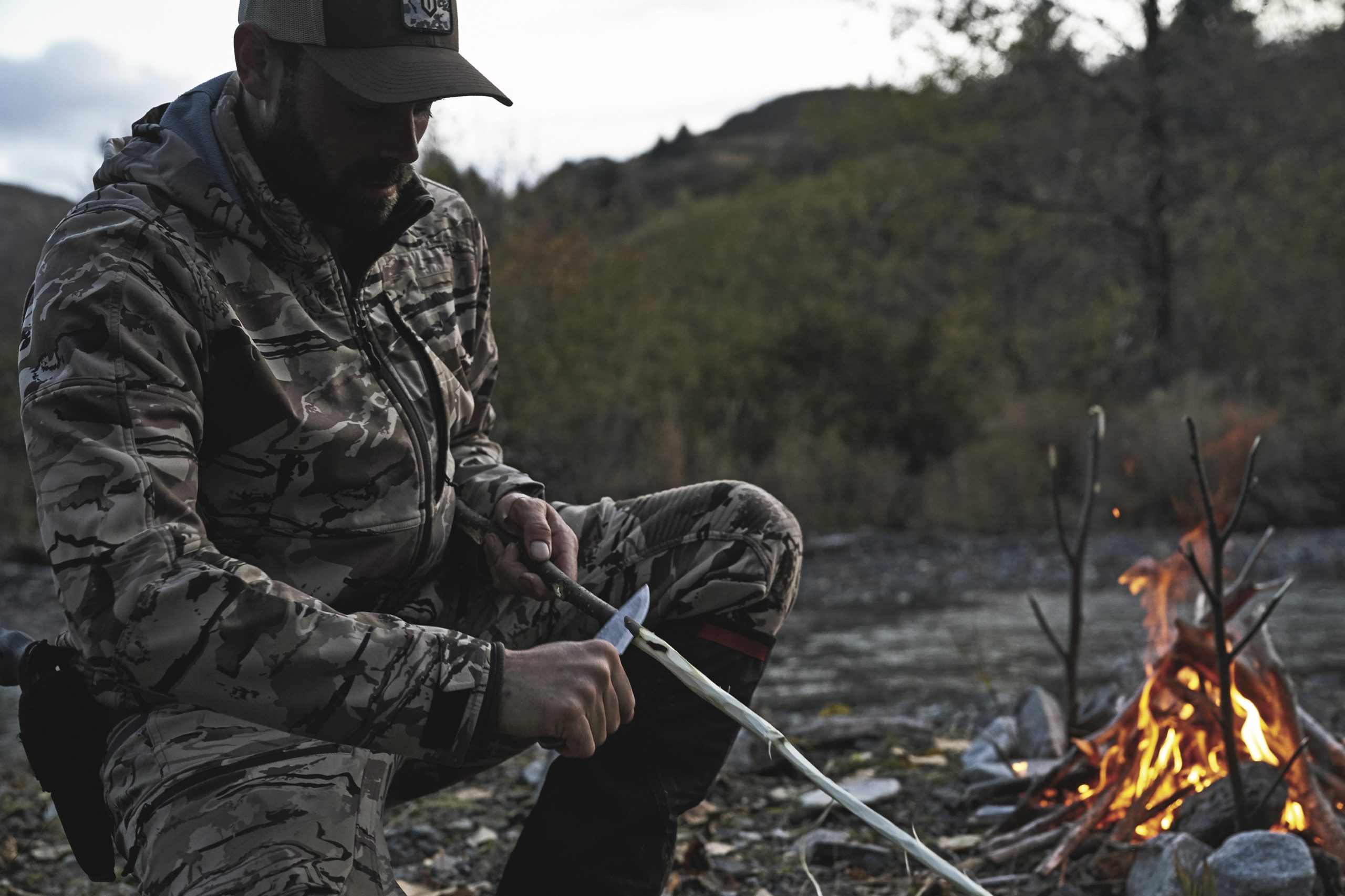
Kindling
Most kindling is going to consist of small sticks. This is what gets the fire going, the purpose of it is to light easier than the larger firewood but burn long enough to get the bigger fire going. The best is to find small dry dead sticks. In wet conditions, kindling may need to be made by breaking and cutting apart larger dead sticks. Kindling is easy to obtain in a camp setting with an ax or hatchet but in a backcountry setting or emergency it can be harder to find and gather. Look toward the base of trees as well as clusters of brush. Avoid rotted woods as they tend to smolder and smoke rather than burn. Think about using your knife and a rock to break down larger pieces of wood if the outside is wet. For this purpose, I prefer to bring a stout knife or multi tool so I can saw or use the knife and rock as a wedge to split larger sticks.
Firewood
This is what keeps the fire going and roaring. If wet, use split dead woods and surround the fire with other wood to dry out. Use the fire you have to keep drying the next wood if needed. If in the backcountry and planning for weather, it is a great idea to gather wood early in the trip and stash it near camp. Place a tarp over it, place in the vestibule of your tent or just stack and cover with brush or pine boughs to keep dry.
Danger
The majority of major “accidents” I have had have been while gathering firewood. Keep this in mind when trying to break off large branches. They often don’t break where you want. Be careful breaking any stick overhead and always protect your eyes, head and body. One time while guiding in Montana, it was near zero degrees out and the winds were 30 mph with 60mph gusts on the ridge. I tucked back into a pocket out of the wind and found a large dead tree. I pulled on a large overhead branch that I thought would burn nicely. Somehow the branch broke where I didn’t expect and the heavy limb hit me square in the head, sending me to the ground… knocked out cold. I think the guys with me thought it killed me. I came-to slightly confused, but thankful that was the extent of the damage.
Another time while I was camping in Africa on a solo trip, I was breaking some firewood off a downed Acacia tree. As the limb broke it was like a baseball swing, burying a large thorn into my leg, only stopped by the bone. I pulled it out with my multi tool but was pretty sore for a few days from that one. I say that to say… watch out. I now gather wood a lot more safely and smarter.
Five Steps for a Perfect Fire
When you really need a fire, you generally only get one shot at making it. In most camping and hunting scenarios you may take all the time in the world to build a fire but when things go south you might only get one shot. Doing it right may save your bacon. Every time you make a fire, make it with that in mind. Go from small to big and follow these five steps to building the perfect fire:
Step 1: Gather materials
The quality of your fire is going to depend on what you gather. Get quality materials and make sure you have a tinder, kindling, and firewood. Make sure you have enough of each. Many fires fail because there is not enough to keep them going. You will waste time and energy gathering enough to start a fire but not enough to build it. Get everything you need first!
Step 2: Prep materials and area
Prep and clear the area where you are going to build your fire. If it is dry, clear out all other grass and brush that may also burn. If it is snowy, I like to lay a layer of green wood or foliage on the snow to build the fire on. Now prep your fire building materials by separating out small sticks, kindling, and bigger wood into piles. Make these piles easy to grab from. This will allow you to quickly add what you need as the fire grows. Also prep your tinder and build the structure to start your fire. I like to start with a loose structure of small sticks that the tinder can ignite quickly while I grab more fuel from my pile and add accordingly. I generally add wood in a teepee or cone shape although a log cabin structure works well also.
Step 3: Ignite
Once you have everything prepped, light the tinder. Lightly blow air onto it to keep the flame up. Try to get your quick-ignition materials to light your long-burning materials. Once the long-burning tinder is lit continue to add fast-burning tinder and kindling.
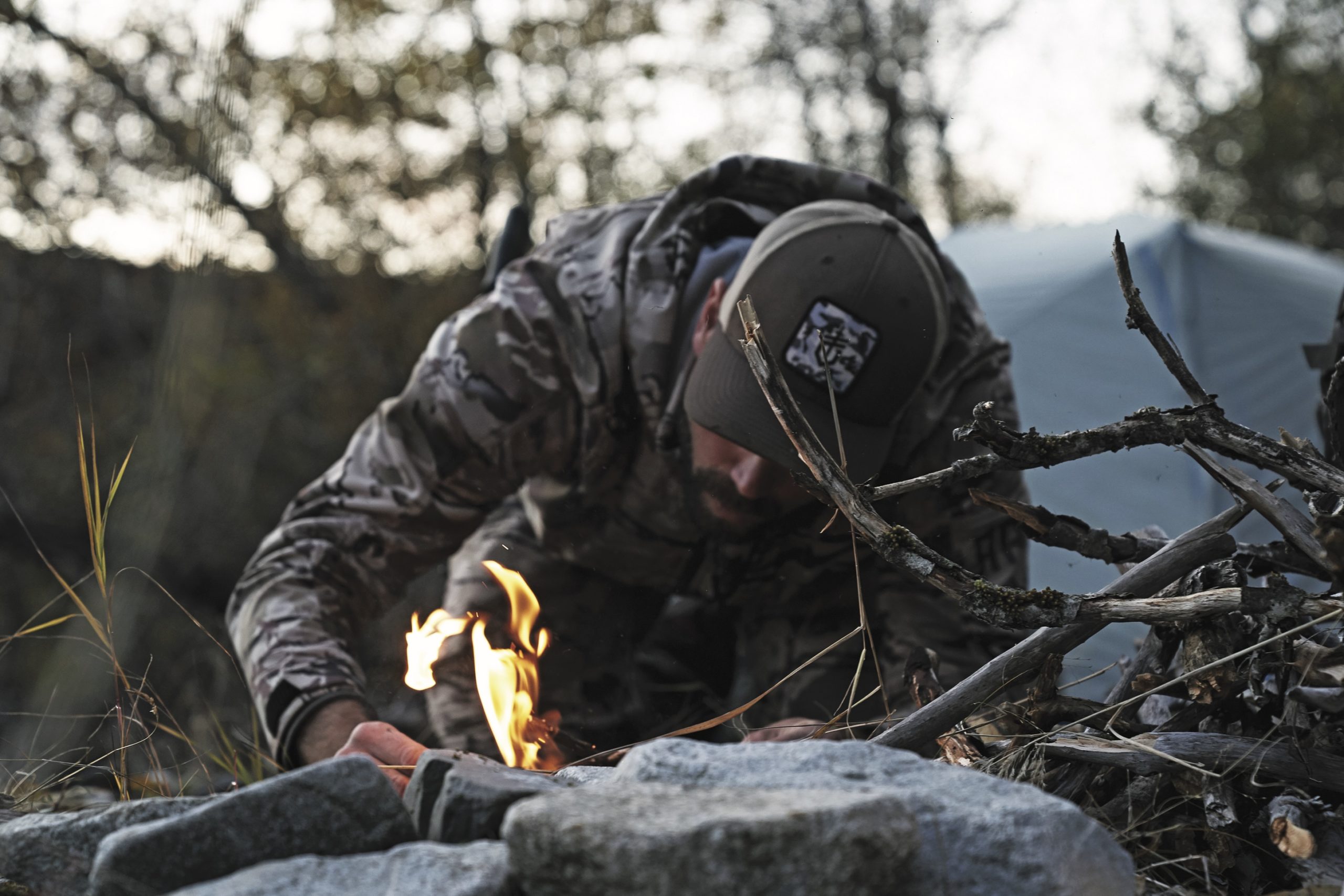
Step 4: Build
Grow the fire from small to big. As you add sticks, add oxygen by blowing on the fire to boost it up. Keep the shape loose enough and don’t add too much and crush the fire. Once a good amount of kindling is burning, start adding larger wood.
Step 5: Maintain
Keep adding wood but allow a few of the larger pieces to burn before adding too many larger pieces and smothering the flame. If the wood is wet, surround the fire with new wood to dry out. Continually add the driest pieces. If the fire burns down but there are still smoking logs, add some tinder and air to the coals. Blowing on the coals should ignite the tinder and bring a good flame back to your logs. Once burning again readjust them and add new wood to maintain the flame.
Bonus tip: Don’t build it under a snowy tree where the snow will fall and put it out.
While a survival fire is important to know how to make, practice making these types of fires is key. Knowing what burns fast where you are hunting is important. I use fires all the time hunting late season elk and deer. There is rarely a day I don’t build a fire while glassing, waiting on elk, or just to warm up quickly when stopped. Once you know the best fuels, you can get fast at building good fires. Practice just like anything else, especially in wet weather or new country that does not have the same trees and plants you are used to. Being good at fire building is not only a great camping skill. It may be a skill that saves your life.
If you do build a fire, just remember to always extinguish it and never build a fire too big or during high fire danger. Use common sense. A few years ago, a large forest fire was started in my area during high winds because some hikers decided to burn their toilet paper after using the bathroom. Laughable, I know, but they claimed to have read a magazine article that suggested that it was what they were supposed to do. So, here is my disclaimer: If you do something stupid, I did not tell you to do it and you should be charged to the full extent of the law for not managing a fire correctly. Build safe fires and extinguish those fires properly.
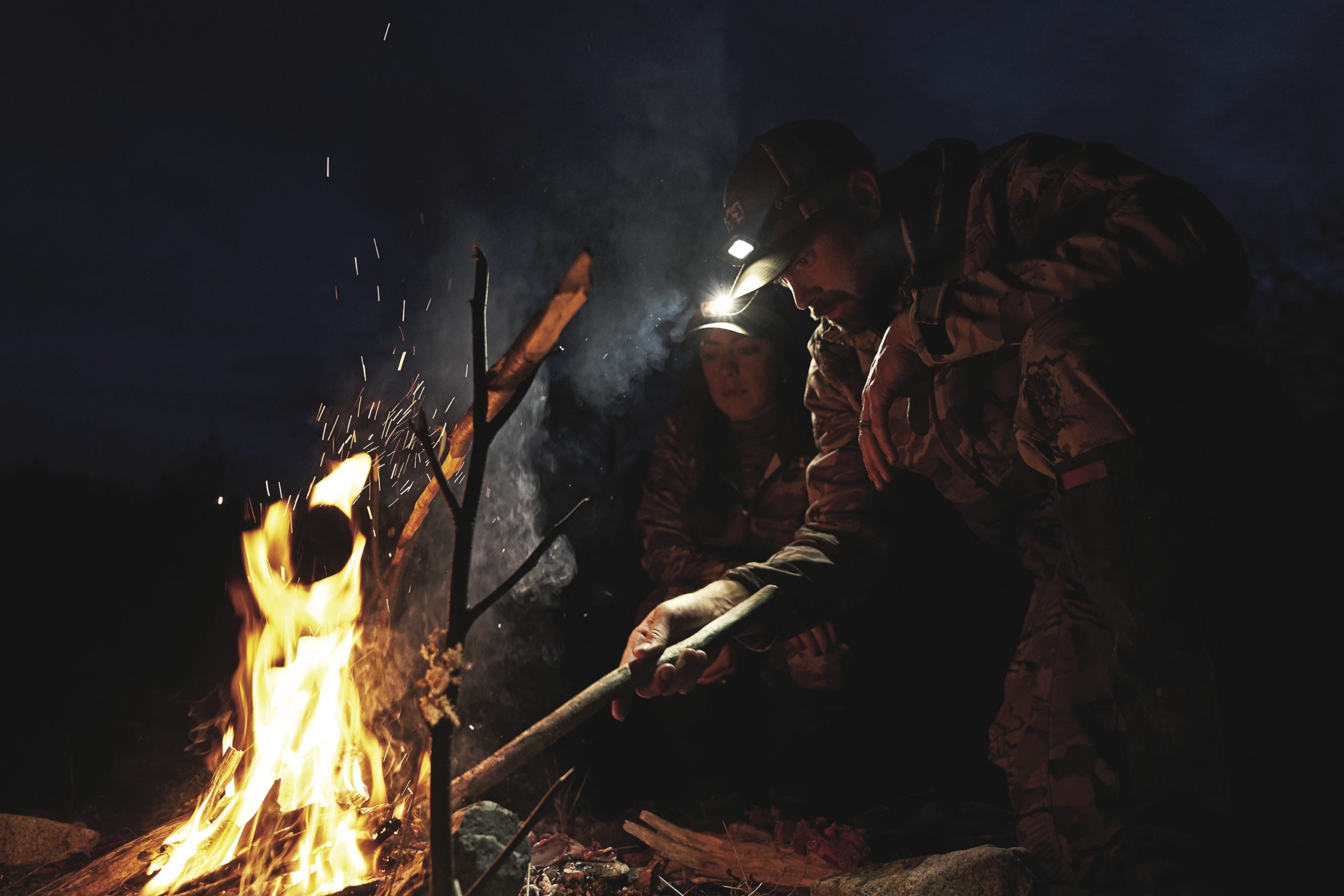
Fire Cooking
Fires are great for keeping you warm but they are also great for cooking. There is nothing better than eating the meat you took after a long day of hunting, cooked over an open fire. Two of my favorite fire cooking methods include skewering meat on a stick and placing it on a spit, using two other branches to prop it up. This can also be done by propping the stick at an angle with rocks.
The other method and the one I think is the best with fresh meat is laying the steak directly on the coals. For some reason even tough fresh meat turns out more tender when cooked this way. Start by pulling large coals into a pile. Next, use your breath to blow as much ash as you can off of the coals. It is not that important to get it all off, but you want the steak to lay directly on the hot embers. The water content in the meat when touching the coals sears the steak but prevents the coal from sticking. It only takes a few minutes per side and you have a deliciously cooked steak. It also adds a great mild smoke flavor you only get from woodfire cooking.
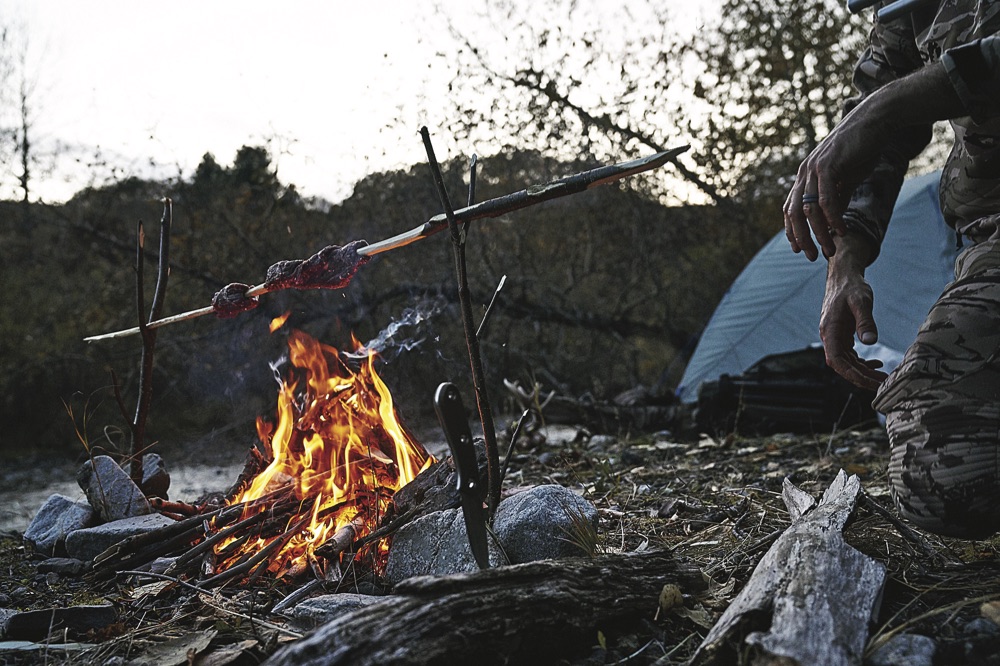
The five best firestarters
#5 Frito chips
One of my favorite hunting chips also puts off a decent flame as the oil on the packed corn burns. I have tried other potato chips with varying success but it is a good idea to think of some items you may already have for fire building. They also make the list because they are delicious.
#4 Paracord
Use the inner strands to ignite and burn as tinder. You probably have something on you that uses this cord, so it makes the list because it is already so handy.
#3 Pine pitch
This can take a bit to ignite but once going, it burns hot for a long period of time and is my go-to for fire building. If I see good hardened pine pitch while hiking, I will generally grab it and store it for use later on down the trail.
#2 The classic homemade firestarter:
Either dryer lint coated in oil or wax, or cotton balls coated in Vaseline. Both of these are standard boy scout tricks that have stood the test of time because they work.
#1 SOL All-Weather Fire Cubes:
These things light with a single spark, burn pretty much no matter what and last long enough to get even stubborn fires roaring. If needed, you can also boil water over one. They are light and convenient.
Some form of fire starter should be a must have in every hunter’s pack.
The Pros and Cons of Fire Tools
Striker
Pro: Never really runs out of fuel and still works when wet.
Con: can be difficult to use
Plasma lighter
Pro: great in wind and wet conditions.
Con: uses a battery
Bic lighter
Pro: puts out a good, real flame.
Con: not great in wind and rain
Waterproof matches
Pro: work when damp, act as a short tinder while burning.
Con: limited to the number of matches you have.
Torch lighter
Pro: decent wind resistance.
Con: uses a shock ignition that can be unreliable.
Bonus tool: A stout knife for making tinder and use as a striker rod on a magnesium rod. A knife or multitool for prepping the fire can be just as important as choosing what you will light the fire with.



